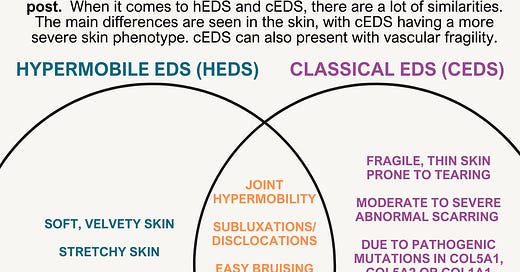Symptom Overlap in Heritable Connective Tissue Disorders
EDS and HSD Awareness Month: When to Suspect Rare Connective Tissue Diseases?
As part of EDS and HSD Awareness Month, I wanted to briefly introduce all connective tissue disorders and answer the common question - “How do I know if it’s “just” hypermobile EDS?”
The landscape of connective tissue disorders (CTDs) is vast and diagnosis can be a challenge when it comes to discerning hypermobile Ehlers-Danlos syndrome (hEDS) from the other rare types of EDS. hEDS is diagnosed solely through clinical assessment, meaning many patients may receive a diagnosis without having genetic testing for other types of EDS or other connective tissue disorders. Ruling out other heritable connective tissue disorders is actually a requirement of the hEDS diagnostic criteria, however, this is often done clinically (but I encourage all patients to get genetic testing if they are able to).
Signs of rare CTDs
While the symptoms of various CTDs may intertwine, certain "red flags" can signal the need for a deeper investigation. These indicators, when combined with other clinical manifestations, prompt consideration for rare connective tissue diseases and may warrant additional genetic testing:
Skin Features: Extreme fragility, sagging, or severe scarring, suggesting conditions like classical EDS or other rare types.
Cardiovascular Manifestations: Aortic root dilation, aortic dissection, or complex heart valve issues, raising suspicion for vascular EDS or related syndromes.
Family History: Consistent patterns of CTDs or rare EDS subtypes in the family tree, urging a closer examination for inherited conditions.
Ocular Anomalies: Notable blue sclerae, retinal detachment, or early-onset cataracts, hinting at syndromic forms of EDS or related disorders.
Skeletal Abnormalities: Frequent fractures, clubfoot, or developmental hip dysplasia, signaling potential syndromic EDS or other skeletal dysplasias.
Developmental Concerns: Intellectual disabilities, distinctive facial characteristics, or hearing loss, necessitating assessment for syndromic EDS or associated syndromes.
Additional Complications: Intracranial aneurysms, organ rupture, or severe periodontal disease, prompting further exploration for rare CTDs or syndromes.
It's essential to acknowledge that the presence of one or even a few of these features does not definitively confirm a rare connective tissue disorder. You should always consult a healthcare provider if you have concerns.
What other connective tissues are there?
Some of the heritable (genetic/inherited) connective tissue disorders are listed below, but many have additional subtypes (over 200 specific heritable connective tissue disorders have been identified).
How does hEDS compare to other EDS subtpyes/CTDs?
I created a few vendiagrams to try and highlight similarities and differences between some of these conditions and hEDS. These are designed to show only some of the similarities and differences and do not include all phenotypes present in these conditions. It also does not mean that these will be consistent for all CTD patients as most present on a spectrum.
Disclaimer: The information provided in this blog serves to highlight the complexities involved in diagnosing rare connective tissue diseases. For personalized medical advice and inquiries concerning your health, please consult a qualified healthcare professional.
Additional Resources and References:
Invitae Connective Tissue Gene Panel
GeneDx Connective Tissue Gene Panel










This is very well written and contains very good information. Would contractures not be another good symptom to list as a sign of a rare CTD?